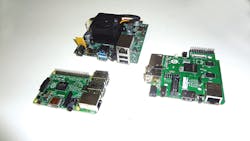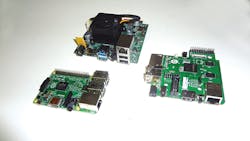I remember when building a computer from scratch was a major undertaking. Hobbyists and developers used to plug together S100 boards to make a system that is less functional than a microcontroller that fits inside a 2 mm by 2 mm chip. The PC revolution was built around motherboards that eventually usurped the collection of peripheral boards that normally included a disk controller, display controller, and network adapter or modem.
These days the entire system fits on a small, single-board system like the Raspberry Pi 2, Gizmo 2, and Creator CI20 (see the figure). They sport USB, 1080p HDMI video, and 1 Gbyte of DRAM.
What can you build with these compact wonders? Just about anything from 3D printer controllers to robots. They even make great multimedia platforms running Kodi (formally XBMC).
Raspberry Pi 2
The $35 Raspberry Pi 2 updates the popular Raspberry Pi by moving to a quad-core, 900 MHz Broadcom BCM2836 system-on-chip (SoC). It has a 10/100 Ethernet port (see “Raspberry Pi 2 Goes Quad Core”). The four USB ports are very handy when turning the system into a compact PC and the microSD slot lets you pack in gigabytes of flash. The 40-pin header provides access to a plethora of expansion boards that have grown up around the Raspberry Pi series.
Gizmo 2
The $199 Gizmosphere Gizmo 2 has a dual-core, AMD GX0210HA APU (see “APU Blends Quad Core x86 with 384 Core GPU”). The Radeon HD 8210-class GPU delivers 85 MFLOPS while using under 9 W of power. It has a miniPCIe/mSATA port underneath, along with a microSD slot. It is a high-performance system with Gigabit Ethernet socket and PCI Express expansion interfaces. It even has a USB 3.0 port. Most compact platforms still deliver USB 2.0. This board exposes additional interfaces using edge connectors. It comes preloaded with TimeSys Linux.
Creator CI20
The $65 Creator CI20 uses Ingenic’s dual-core, 1.2 GHz JZ4780 that is based on Imagination’s MIPS32 processor with a PowerVR SGX 540 GPU. The GPU is similar to what is found in an iPhone 4. Digilent's chipKIT Max32 uses Microchip’s PIC32 that is also based on the MIPS32 architecture (see “Arduino, Raspberry Pi or BeagleBone?”).
The CI20 has 10/100 Ethernet, but it also has Bluetooth and 802.11b/g/n support. The other two need additional boards for wireless support. It actually makes a very nice wireless bridge for Internet of Things-type applications.
These days Linux typically is the operating system of choice with Linux-based Android a close second. Platforms like the Gizmo 2 can run Microsoft Windows and other x86 operating systems out of the box.
While all three are similar in size, they are quite different in features and target applications. They get mixed in with platforms like Arduino, BeagleBone, and Edison. They are all readily available from a range of suppliers like Avnet, DigiKey, Element14, Mouser, and Sparkfun.
About the Author
William Wong Blog
Senior Content Director
Bill's latest articles are listed on this author page, William G. Wong.
Bill Wong covers Digital, Embedded, Systems and Software topics at Electronic Design. He writes a number of columns, including Lab Bench and alt.embedded, plus Bill's Workbench hands-on column. Bill is a Georgia Tech alumni with a B.S in Electrical Engineering and a master's degree in computer science for Rutgers, The State University of New Jersey.
He has written a dozen books and was the first Director of PC Labs at PC Magazine. He has worked in the computer and publication industry for almost 40 years and has been with Electronic Design since 2000. He helps run the Mercer Science and Engineering Fair in Mercer County, NJ.
- Check out more articles by Bill Wong on Electronic Design
- Bill Wong on Facebook
- @AltEmbedded on Twitter

